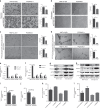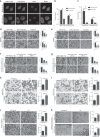LncRNA-HNF1A-AS1 functions as a competing endogenous RNA to activate PI3K/AKT signalling pathway by sponging miR-30b-3p in gastric cancer
- PMID: 32336754
- PMCID: PMC7283217
- DOI: 10.1038/s41416-020-0836-4
LncRNA-HNF1A-AS1 functions as a competing endogenous RNA to activate PI3K/AKT signalling pathway by sponging miR-30b-3p in gastric cancer
Abstract
Background: Accumulating evidence demonstrated that long noncoding RNAs (lncRNAs) played important regulatory roles in many cancer types. However, the role of lncRNAs in gastric cancer (GC) progression remains unclear.
Methods: RT-qPCR assay was performed to detect the expression of HNF1A-AS1 in gastric cancer tissues and the non-tumourous gastric mucosa. Overexpression and RNA interference approaches were used to investigate the effects of HNF1A-AS1 on GC cells. Insight into competitive endogenous RNA (ceRNA) mechanisms was gained via bioinformatics analysis, luciferase assays and an RNA-binding protein immunoprecipitation (RIP) assay, RNA-FISH co-localisation analysis combined with microRNA (miRNA)-pulldown assay.
Results: This study displayed that revealed expression of HNF1A-AS1 was associated with positive lymph node metastasis in GC. Moreover, HNF1A-AS1 significantly promoted gastric cancer invasion, metastasis, angiogenesis and lymphangiogenesis in vitro and in vivo. In addition, HNF1A-AS1 was demonstrated to function as a ceRNA for miR-30b-3p. HNF1A-AS1 abolished the function of the miRNA-30b-3p and resulted in the derepression of its target, PIK3CD, which is a core oncogene involved in the progression of GC.
Conclusion: This study demonstrated that HNF1A-AS1 worked as a ceRNA and promoted PI3K/AKT signalling pathway-mediated GC metastasis by sponging miR-30b-3p, offering novel insights of the metastasis mechanism in GC.
Conflict of interest statement
The authors declare no competing interests.
Figures






Similar articles
-
Down-regulated lncRNA SLC25A5-AS1 facilitates cell growth and inhibits apoptosis via miR-19a-3p/PTEN/PI3K/AKT signalling pathway in gastric cancer.J Cell Mol Med. 2019 Apr;23(4):2920-2932. doi: 10.1111/jcmm.14200. Epub 2019 Feb 22. J Cell Mol Med. 2019. PMID: 30793479 Free PMC article.
-
Long non-coding RNA HNF1A-AS1 mediated repression of miR-34a/SIRT1/p53 feedback loop promotes the metastatic progression of colon cancer by functioning as a competing endogenous RNA.Cancer Lett. 2017 Dec 1;410:50-62. doi: 10.1016/j.canlet.2017.09.012. Epub 2017 Sep 21. Cancer Lett. 2017. PMID: 28943452
-
LncRNA NKX2-1-AS1 promotes tumor progression and angiogenesis via upregulation of SERPINE1 expression and activation of the VEGFR-2 signaling pathway in gastric cancer.Mol Oncol. 2021 Apr;15(4):1234-1255. doi: 10.1002/1878-0261.12911. Epub 2021 Feb 13. Mol Oncol. 2021. PMID: 33512745 Free PMC article.
-
The long noncoding RNA CRAL reverses cisplatin resistance via the miR-505/CYLD/AKT axis in human gastric cancer cells.RNA Biol. 2020 Nov;17(11):1576-1589. doi: 10.1080/15476286.2019.1709296. Epub 2020 Jan 7. RNA Biol. 2020. PMID: 31885317 Free PMC article. Review.
-
Beyond the genome: lncRNAs as regulators of the PI3K/AKT pathway in lung cancer.Pathol Res Pract. 2023 Nov;251:154852. doi: 10.1016/j.prp.2023.154852. Epub 2023 Oct 4. Pathol Res Pract. 2023. PMID: 37837857 Review.
Cited by
-
Integrative analysis of the gastric cancer long non-coding RNA-associated competing endogenous RNA network.Oncol Lett. 2021 Jun;21(6):456. doi: 10.3892/ol.2021.12717. Epub 2021 Apr 8. Oncol Lett. 2021. PMID: 33907566 Free PMC article.
-
KB-68A7.1 Inhibits Hepatocellular Carcinoma Development Through Binding to NSD1 and Suppressing Wnt/β-Catenin Signalling.Front Oncol. 2022 Jan 20;11:808291. doi: 10.3389/fonc.2021.808291. eCollection 2021. Front Oncol. 2022. PMID: 35127520 Free PMC article.
-
The role of microRNAs in the gastric cancer tumor microenvironment.Mol Cancer. 2024 Aug 20;23(1):170. doi: 10.1186/s12943-024-02084-x. Mol Cancer. 2024. PMID: 39164671 Free PMC article. Review.
-
Long non-coding RNA CNALPTC1 promotes gastric cancer progression by regulating the miR-6788-5p/PAK1 pathway.J Gastrointest Oncol. 2022 Dec;13(6):2809-2822. doi: 10.21037/jgo-22-1069. J Gastrointest Oncol. 2022. PMID: 36636079 Free PMC article.
-
The lymphatic vasculature: An active and dynamic player in cancer progression.Med Res Rev. 2022 Jan;42(1):576-614. doi: 10.1002/med.21855. Epub 2021 Sep 5. Med Res Rev. 2022. PMID: 34486138 Free PMC article. Review.
References
-
- Shi Y, Zhou Y. The role of surgery in the treatment of gastric cancer. J. surgical Oncol. 2010;101:687–692. - PubMed
-
- Duraes C, Almeida GM, Seruca R, Oliveira C, Carneiro F. Biomarkers for gastric cancer: prognostic, predictive or targets of therapy? Virchows Arch.: Int. J. Pathol. 2014;464:367–378. - PubMed
-
- Guo G, Kang Q, Zhu X, Chen Q, Wang X, Chen Y, et al. A long noncoding RNA critically regulates Bcr-Abl-mediated cellular transformation by acting as a competitive endogenous RNA. Oncogene. 2015;34:1768–1779. - PubMed
-
- Sun M, Nie F, Wang Y, Zhang Z, Hou J, He D, et al. LncRNA HOXA11-AS promotes proliferation and invasion of gastric cancer by scaffolding the chromatin modification factors PRC2, LSD1, and DNMT1. Cancer Res. 2016;76:6299–6310. - PubMed
Publication types
MeSH terms
Substances
LinkOut - more resources
Full Text Sources
Medical
Miscellaneous

